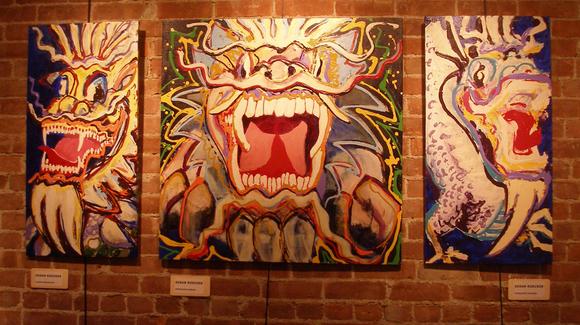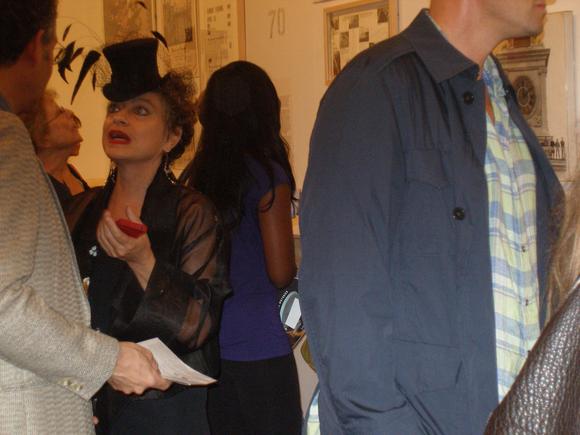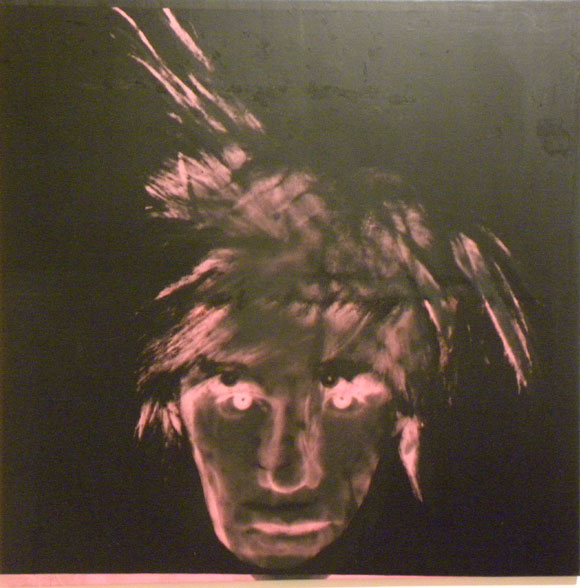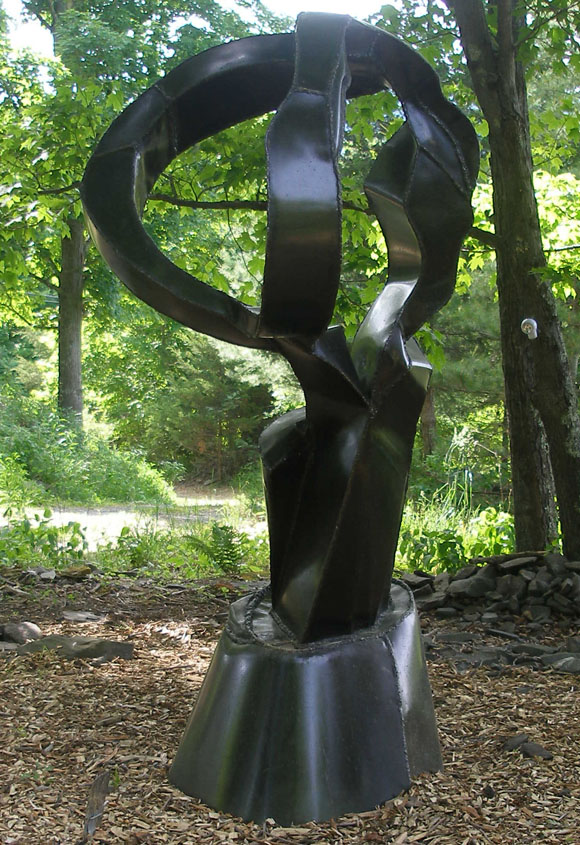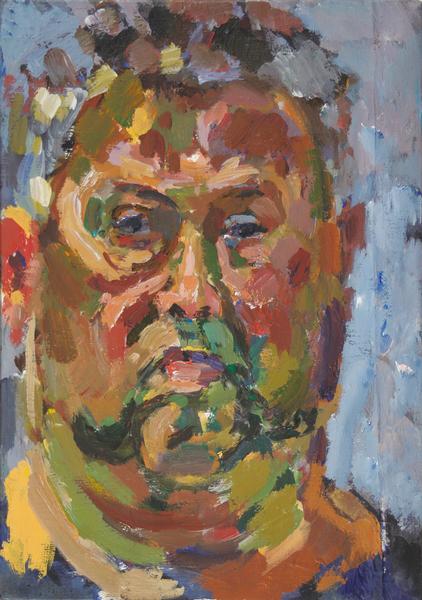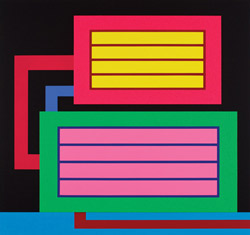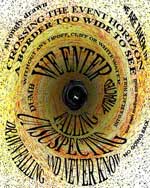
-- A Cyberspace Review Of The Arts
Volume 17.24
October 10, 2010
|
Self-Destroying Art by Gordon Fitch |
|||
|
|
|||
|
INNOVATIVE ARTS: by Robert Sievert
|
|||
|
|
|||
|
EXIT ART: ALTERNATIVE HISTORIES
by Robert Sievert
EXIT ART is a gallery that has been around for 27 years. It had a space downtown where they specialized in fringe art, art that was out of the mainstream. Now Exit Art has morphed into "arts center" that has a space on 10th Avenue and 36th St. This was the site for a new show, ALTERNATIVE HISTORIES, that opened September 24, 2010. The point of the show was to document the ALTERNATIVE CULTURE of the past 50 years. . . . |
|||
|
|
|||
|
I remember in or around 1975 going to OK Harris to see Andy Warhol's show of large 'political' paintings of Mao and his 'Hammer And Sickles' wanting to hate them, but resigned that they were just too good to disparage. Warhol had made serious painting irrelevant, which annoyed me. Reading this book was quite a revelation. |
|||
|
|
|||
|
|||
|
|
|||
|
NINE at Saugerties
by Robert Sievert
Our intrepid editor went to Saugerties to see 'Nine',
an exhibition of nine artists at the Clove Church.
Our editor in a church?
|
|||
|
|
|||
Nicolas Carone, 1917 - 2010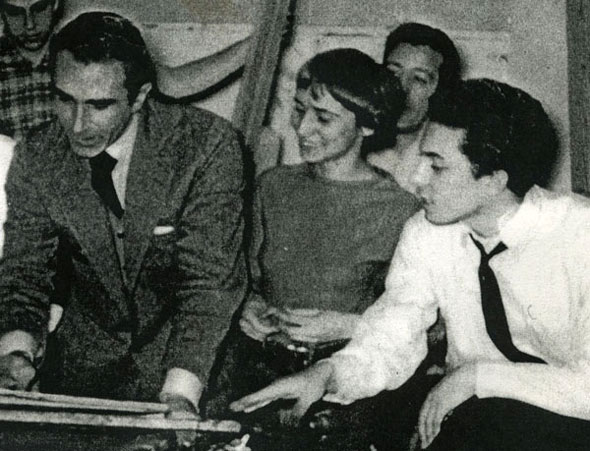 Nick Carone with students (1959) by Robert Sievert Nicolas Carone died on July 15, 2010. He was a supremely talented artist and influential teacher. He has had 3 major showings of his work in the last three years and has easily risen to the ranks of major practitioner of American Abstract Painting. |
|||
|
|
|||
Dead Flowers
|
|||
|
|
|||
|
Book Review: 
book cover of "A Painter's Life" by Robert Sievert
If you live in New York and are familiar with the art world you may think that it is something goes on only in the big towns. K.B. Dixon's A Painter's Life belies such thoughts with an interesting account of a fictional painter, Christopher Freeze. The book is set as a series of notes by Christopher Freeze. It reveals the ongoing life of an artist living in parts of America's West, first Phoenix, then the Northwest. The notes are like diary entries; then there are excerpts of various reviews and sections of "unpublished journals." |
|||
|
|
|||
|
Bill Jensen 
Bill Jensen: Linen by Juan Seoane Cabral
| |||
|
|
|||
|
Richard LaPresti
by Robert Sievert Richard LaPresti's current show at the Bowery Gallery(March 30-April 24) is a revival of many familiar themes. For many years this artist has stuck to subject matter in which he is obviously comfortable and free to work. Self-portraits, landscapes and (my personal favorites) his beach scenes which I believe first started to appear in the 70's. | |||
|
|
|||
|
Pinhole Camera Pictures 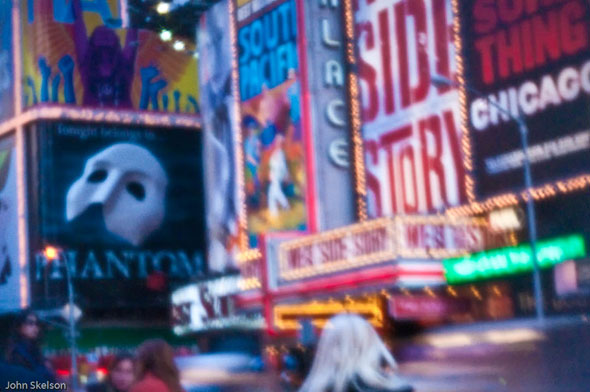
by Robert Sievert
I have been admiring the pin hole photography that I have been seeing as the results of the workshops John Skelson has been doing at the Art Lab (Snug Harbor, Staten Island). First there was a raucous shot of Times Square (above) that he showed at an exhibit at the Art Lab. There is a distinct feeling of unreal light generated by all the neon and glare of the theater signs. By minimizing the details the overall aura of the shot is allowed to take prominence. Skelson has figured out how to use a high end digital camera to produce pin hole images. Phyllis Featherstone has been working with Skelson and has produced some rather remarkable images. Her shot of some bottles really bought to mind the writings of Aldous Huxley. In Doors Of Perception he talks about seeing the "Dharma Body", the essential aspect of an object that is seen once the mind is cleared of superficial identities. That is what I think is so compeling about these images. They are closer to visions than ordinary photography. They eschew the mundane for the essential. |
|||
|
|
|||
|
Peter Halley 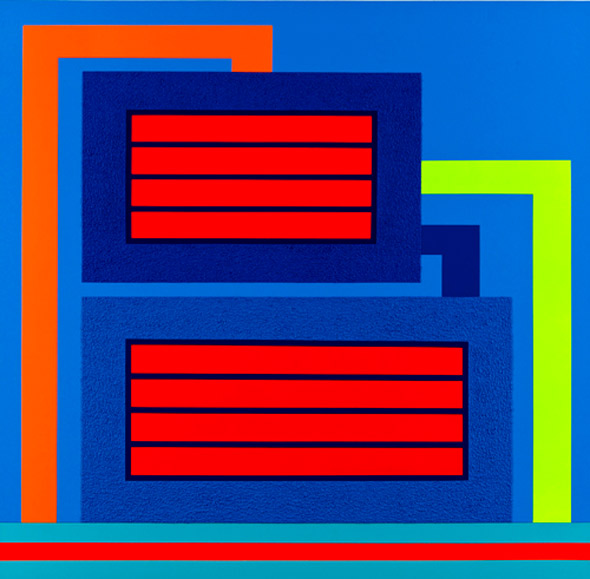
by Robert Sievert
|
|||
|
|
|||
|
BRONZINO drawings at the Met 
by Robert Sievert Several interesting things emerge when one visits the Bronzino exhibit at the Metropolitan Museum (now through April 17). One thing is the scarcity of paper at the disposal of Renaissance artists. These drawings (60 of the known 62) are mostly done on letter-sized pages; many spaces are filled with more than one image. . . .
|
|||
|
|
|||
|
|||
|
|
|||
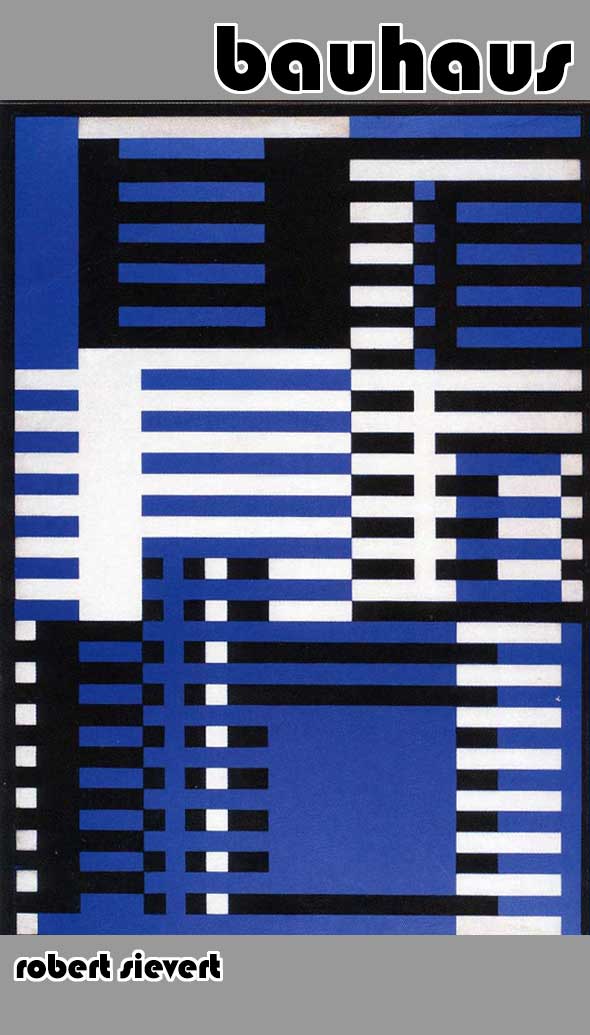
I can remember 1956 clearly; I had just graduated from high school and I was in love with German Art. I thought the Bauhaus was the most amazing historic phenomenon and because of my youth did not realize it had all happened only 20 to 30 years before then. I saw a magnificent exhibit of Paul Klee at the newly designed futuristic World House Gallery. I came in possession of a MoMA book on the Bauhaus. I listened endlessly to Kurt Weill music and poured through books on Bauhaus era Art. I began my studies at Parsons School of Design in their Industrial Design department. Many of the faculty there came from Yale and in some way represented a continuance from the Bauhaus. I forgot most of this until last month when then I visited MoMA to see the new exhibit they have mounted on the Bauhaus. As I walked through the galleries it all came back and once again I came under the influence of the Bauhaus. ...
|
|||
|
|
|||
|
Two Book Reviews 
— by Gordon Fitch
Robert Crumb's Genesis
and a collection of "neo-gothic" or "hyperreal" art called
Art That Creeps. Read the reviews
|
|||
|
|
|||
|
|||
|
|
|||
|
|||
|
|
|||

Alicia Amador: NO SOMOS IGUALES (Egg tempera/canvas, 35.4" x 35.4", 2009) Those Vanishing DaysTaller Artifex at Blue Mountainby Robert SievertTempera is the oldest known type of painting known. It was used in early Egypt and Greece and remained the reigning art technique until the development of oil painting in the Renaissance. Not being that familiar with tempera myself, I will give you what I know. One works on a panel or canvas with pigment that is mixed with egg yolk. The process has always seemed difficult to me as one has to amass dry pigments and mix them on demand. Also one can only mix small batches at a time and this medium is fast drying. But I have seen some remarkable work in tempera. New York artist Tomar Levine painted an unforgettable still life using tempera. To this day, years later, I remember the clarity and brilliance of the painting, especially notable, a robin's egg placed on a saucer. What is most memorable is the radiant blue of the bird's egg. Tempera can have some dazzling effects So when a show of beautiful paintings with a spirited glow and done in tempera arrives it seems like a special event. THOSE VA(R)NISHING DAYS was the title of an exhibition of a group of artists from Mexico City who all work in tempera. (The play on vanishing/varnishing is elaborated in their catalog). The group seem to be a studio, Taller Artifex, who produced a beautiful exhibition seen this summer at the BLUE MOUNTAIN GALLERY. This is a most compelling group of artists. They work in a variety of styles but there was a remarkable consistency to the work. |
|||
|
|
|||

David Mollet at the Bowery Galleryby Robert SievertOne of the unfortunate occurrences in the change in format Artezine underwent this spring was that certain articles were put on hold. None was more grievous than the omission of one of the best landscape shows of the season, David Mollet at the Bowery Gallery last winter. Mollet is foremost in a Modernist tradition and school of painting. Mostly furthered by the descendents of Abstract Expressionism, chiefly practitioners of a method inspired by Hans Hoffman. Hoffman's acute analysis of the picture plane could be taught. He educated a whole generation of artists who were able to put into use the principles of the master, fusing the principles of abstraction with various degrees of figuration. Now there is a second generation of artists taught by these artists. |
|||
|
|

A State Fair In QueensSocrates Sculpture Park Goes To The Countryby Gordon FitchNote: each image below is linked to a larger version which can be viewed by clicking on the small one. Queens is reputed to have something like 157 different ethnic groups, each with its own language and culture. Perhaps almost as remote from the common experience of most of the locals in Astoria and Long Island City as the marches of Uzbekistan (except for our Uzbek contingent) this summer's Current Exhibition, "State Fair", was themed on the eponymous public events of America's rural areas. Artists were invited to connect the historic state fair of traditional rural America with the polymorphous 21st-century physical reality of urban Queens, within sight of the tallest of Manhattan's tall, glittering towers, and indeed in the literal glitzy shadow of advancing gentrification. The curator of this exhibition did not intend a crowded, noisy state fair atmosphere, so the results, while popular enough, were somewhat less frantic than the Platonic form of the state fair, but fit in very well with the park's neighborly, congenial atmosphere. The resultant works were diverse and surprising: above, you see one of them, a "barn" devised by Bernard Williams. But there is more, much, much more. |
||
|
|
|||
German Art At Blue Mountain Galleryby Robert Sievert
Barbara Deutschmann: "Pocket Sculpture" In an interesting experiment Marcia Clarke, director of Blue Mountain Gallery arranged an exchange show with Galerie Mani of Berlin. They would have our Gallery for a show and in exchange Blue Mountain would have a show in Berlin. (For Galerie Mani's announcement of the Berlin show, see this PDF.) When one thinks of German Art one immediately thinks of the great expressionists of German Art and the power and graphic strength of their work. What we got was not exactly that. Four artists of rather uneven accomplishment were presented. Granted that the work was complicated by the obvious size restrictions of transporting it internationally, most pieces were small. The group consisted of four artists, maybe it is unfair to expect Galerie Mani to represent German Art but the show certainly lacked power and graphic strength. ... |
|||
|
|
|||
“Harsh Beauty in the Smashing Elements”
Black Sunrise Louise Guerin at Blue Mountain Galleryby Robert SievertLouise Guerin's new paintings, to be seen Blue Mountain Gallery in April and May, are bold expressionist images. She is at her best in a series of almost black and white painntings that seem to explode off her canvases. Her paintings of Utah's Park City and a beach in New Zealand seem to mark a real step forward into expressive painting. Guerin was an artist in residence at Utah's Park City last Spring and was surprised to find herself wanting to paint that landscape, since it was so unfamiliar to her. The solemn majesty of the high peaks around Park City and the quiet hush of the salt flats of Salt Lake itself both captured her imagination and ended up in very different but equally forceful canvases. Guerin sensed massive forces as she painted this current landscape exhibition -- a deep disquiet in the air -- the pounding surf in these imposing seascapes certainly does not invite thoughts of swimming. The geographic location is her homeland of New Zealand but the general atmosphere echoes the current worldwide uncertainty in all spheres. The paintings take on an allegorical significance and mythological forces seem to be at work here. Guerin worked from drawings and photos of a beach she has been visiting all her life. Her animated brushstrokes match the crashing waters and the sense of impending danger and challenge. The huge pieces of driftwood being washed up could be survivors of an unknown struggle further up the coast or a transplanted version of Mathew Brady's battlefield corpses from Antietam. Harsh beauty in the smashing elements.

Utah Sunrise |
|||
|
|
|||
NICOLAS CARONE at WASHBURN GALLERY Off The Chart, 2009, acrylic on tarpaulin, 42"x33" by Robert SievertWhen I asked the man behind the desk at the Washburn Gallery "Just how old is Nick?" he hesitated and then said, "92?" It was almost an apology. The paintings on view in the other room were all done in the past year. An amazing feat for an artist who is challenged by vision problems and what ever else comes along with being 92. No apology needed. Done in black and white, there is a visual excitement and sense of intensity in this work. Probably the finest work Carone has done yet. This work follows a similar series shown last year at the Washburn gallery. Those were not new paintings but had been in his studio for quite awhile. I had seen them at least five years ago. They also were black and white. But it is in this new series currently on view that Carone has made his most definitive expression of his artistic vision yet. It is as if the attention of his last show has catapulted him into renewed energy and certainty. |
|||
|
|
|||
Visual Poetry by Diana Manister

-- more -- |
|||
|
|
|||
[]
|
|||
|
|
|||
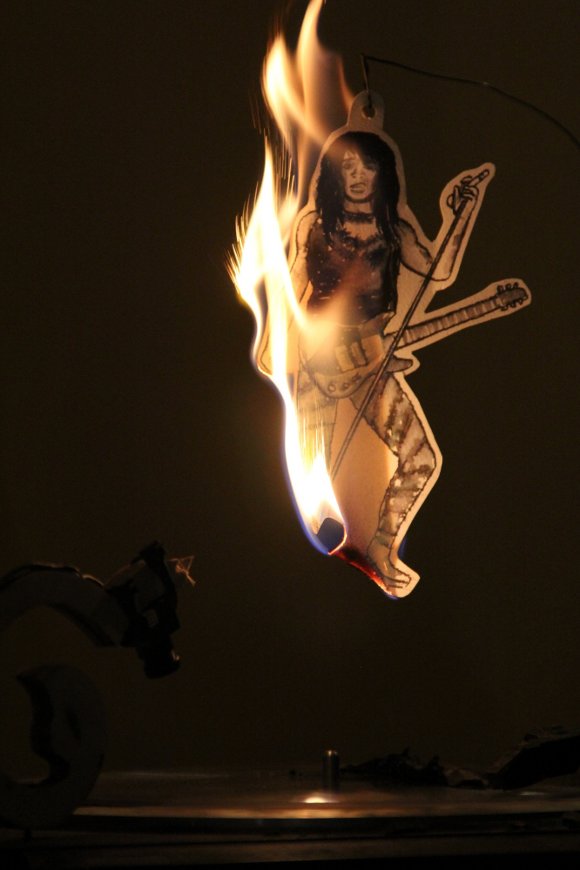
 — Read about it here .... —
— Read about it here .... — 